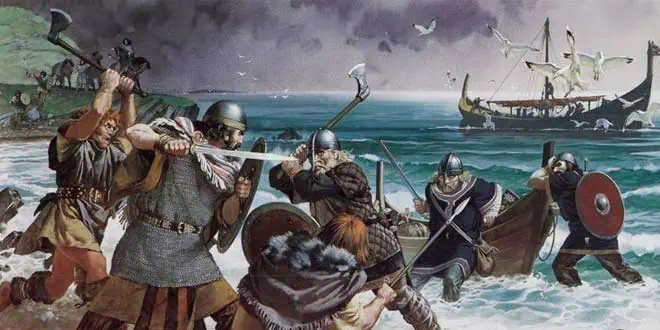Few names evoke the essence of the Scandinavian warrior like Ragnar Lothbrok, a key figure of the Viking period.
Although his exact existence remains debated, medieval sources portray him as a warrior who led raids into England, France, and other European regions.
Their legend, recorded in Norse sagas such as the Ragnarssaga Loðbrókar and the Gesta Danorum, has profoundly influenced modern perceptions of the Vikings.
Two weapons accompany him in each story: his Viking axe and his sword, symbols of power and Scandinavian war culture.

Who was Ragnar Lothbrok?
Ragnar Lothbrok (also spelled Lodbrok) was a Scandinavian warrior who, according to written Norse accounts, lived in the 9th century.
Although his historical existence is debated, medieval texts place him as king of Denmark and Sweden, famous for his raids on England, France, and even the Iberian Peninsula.
He is credited with fathering equally legendary warriors such as Bjorn Ironside, Ivar the Boneless, Sigurd Snake-in-the-Eye, and Ubbe.
The sources that mention him, such as the Gesta Danorum or written Icelandic accounts, describe him as a charismatic leader, relentless in battle and devoted to the Norse gods. But what distinguishes him from other Vikings is his tragic fate: captured by King Ælla of Northumbria, he was executed by throwing him into a pit of snakes, where he proudly uttered his last words: "How the little pigs roar when they hear the boar in pain!"
Ragnar's Viking axe:
the extension of his warrior soul
In the Viking context, the battle axe was more than a weapon: it represented the warrior's identity. Ragnar Lothbrok's alleged axe was based on historical models such as the bearded axe, with a curved edge, a steely iron blade, and an ash or oak handle engraved with runes.
The Viking forging process began with iron extracted from Scandinavian peat bogs. Blacksmiths used bellows and rudimentary furnaces to reach the necessary temperatures.
Some axes included damascened steel, which improved strength and created a wavy pattern on the blade.
Axes weren't simply offensive tools. They were believed to be imbued with spiritual power, sacred to deities like Odin and Tyr, and their proper forging was essential to the balance between death and glory. Given Lothbrok's depicted devotion to the Norse gods, his axe was likely no exception.
Furthermore, Ragnar's sword would have been used in documented raids, such as the attacks on Lindisfarne or Paris.

Ragnar's Sword: Elegance and Death
The Viking sword was a symbol of nobility. Its possession was reserved for leaders, jarls, and kings.
Ninth-century swords, such as the one attributed to Ragnar, were double-edged, with a straight blade, short guard, and ornate pommel. These weapons were inspired by Carolingian designs, widely prevalent in Western Europe during that period.
Forging these swords required precise alloying and techniques such as layer welding. Each piece could take months to complete.
The best Viking swords were imported or looted from Frankish territories, then recast and customized.
Ragnar's sword likely bore runic inscriptions, and the hilt was wrapped in tanned leather, bone, or silver. Its design provided an advantage in close combat, and it was effective both in frontal charges and in single duels.
Cultural influence and legacy
Ragnar Lothbrok has been the subject of multiple reinterpretations.
It appears in medieval texts, Christian chronicles, and modern adaptations such as the Vikings series.
His figure has popularized interest in Viking weaponry, medieval forging, Norse religion, and Scandinavian warrior traditions.
Today, replicas of his sword and axe are crafted using traditional techniques. His forgers reconstruct these weapons as part of their study of Viking heritage.
Ragnar has become a symbol of resilience, strategy and leadership.
There are museums in Oslo, Copenhagen, and Reykjavík that display authentic Viking weapons very similar to those attributed to him.









